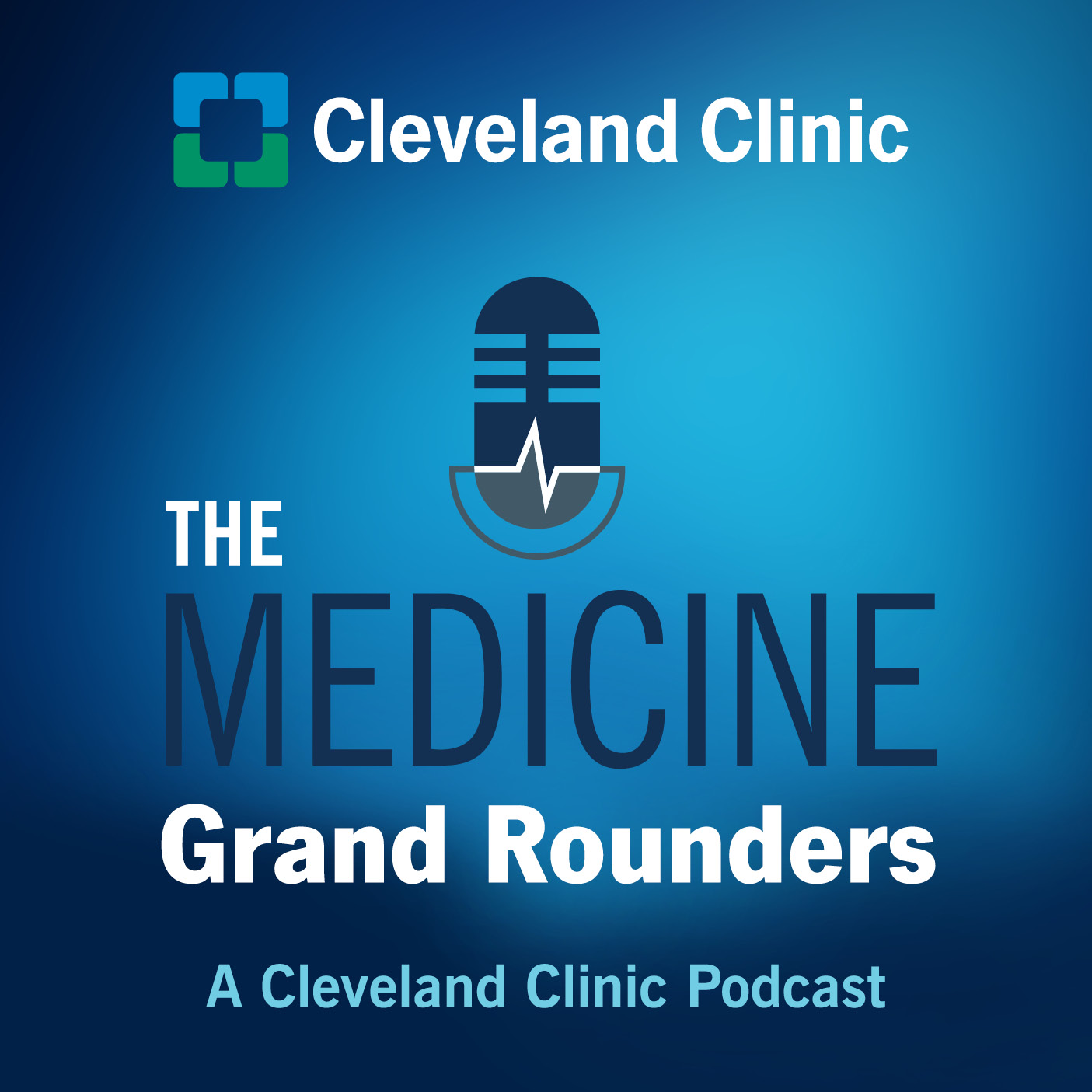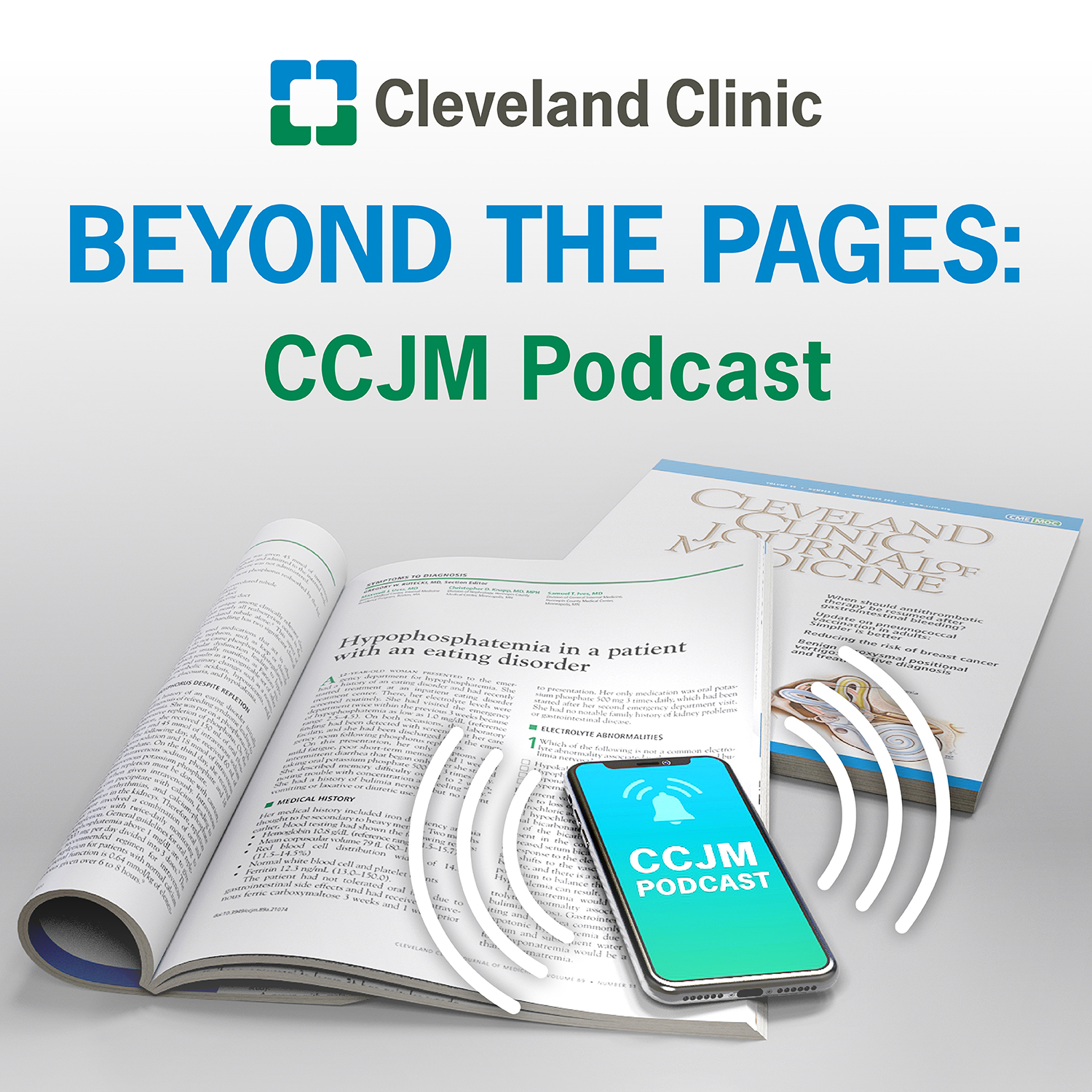Glomerulopathies - A Deep Dive for Internists with Dr. Ali Mehdi

In this episode of the Medicine Grand Rounders, Dr. Ali Mehdi takes a deep dive into the world of Glomerulopathies. Moderated by Tarek Souaid, MD, MPH.
Subscribe: Apple Podcasts | Podcast Addict | Buzzsprout | Spotify
Glomerulopathies - A Deep Dive for Internists with Dr. Ali Mehdi
Podcast Transcript
Segment 1: Glomerulopathies – Definition and Presentation
Wardrop: Dr. Mehdi let's start at the beginning. What exactly are glomerulopathies and how do they present in patients?
- Glomerulopathies are diseases affecting the renal glomeruli. The glomeruli are the filtering units of the nephrons. These conditions can manifest with various symptoms, including proteinuria (excessive protein in the urine), hematuria (blood in the urine), hypertension, and can potentially progress to end-stage renal failure.
- Generally categorized based on their clinical presentation into two syndromes: nephrotic vs. nephritic (aka glomerulonephritis). These two syndromes reflect different mechanisms of glomerular injury and have distinct clinical features, laboratory findings, and implications for treatment.
- Nephrotic syndrome: is marked by a high degree of proteinuria (typically >3.5 grams per 24h), hypoalbuminemia, severe edema, and oftentimes associated with hyperlipidemia. The massive proteinuria results from increased permeability of the glomerular filtration barrier, particularly affecting the podocytes.
- Nephritic syndrome: is due to glomerulonephritis, or GN, an inflammation of the glomeruli. Think of it as a storm brewing in the kidney's filtration system, leading to symptoms like blood in the urine, protein leakage, and swelling.
Segment 2: Nephrotic Syndrome
Tarek: Let’s assume we are suspecting nephrotic syndrome in a patient that presents with lower extremity edema, hypoalbuminemia and proteinuria. What should be our next steps?
Dr. Mehdi:
- Important to rule out other differentials: It's essential to distinguish NS from other causes of edema such as heart failure, liver disease, or other kidney disorders. Indicators like rapid progression, hypertension, and prominent hematuria, including casts and dysmorphic red blood cells, may suggest nephritic syndrome instead.
- Adequate quantification of proteinuria: The gold standard is a 24-hour urine collection. However, spot protein/creatinine and albumin/creatinine ratios are quicker alternatives. The spot ratio's accuracy depends on daily creatinine excretion, which can vary among individuals.
- Urine dipstick limitations: Dipsticks primarily measure albumin, and urine concentration can significantly influence results. In NS, albumin is typically the dominant protein in the urine, but more precise measurements are obtained from a protein/creatinine ratio or 24-hour urine collection.
- Once NS is diagnosed, additional tests are recommended to identify its etiology, including SPEP/UPEP for multiple myeloma, ANA for lupus, hepatitis serologies, HIV screening, and anti-PLA2R titer for idiopathic membranous nephropathy. CBC and coagulation profile will be needed prior to obtaining a biopsy if needed.
Tarek: Talking about diagnostic tests, what are the major causes of NS that we need to keep in mind?
Dr. Mehdi:
We need to distinguish between the histological diagnosis and definite etiologic diagnosis.
For example, diabetic nephropathy, membranous nephropathy, focal segmental glomerulosclerosis (FSGS), minimal change disease (MCD), light chain deposition, amyloidosis can be seen on the biopsy. MCD can be either primary or secondary, therefore we do not always get a definite diagnosis with the biopsy and sometime we need to go search for a wide range of secondary causes of nephrotic syndrome.
Tarek: While awaiting the results of our etiologic workup, how do you recommend managing the patients’ symptoms?
Dr. Mehdi: The general management of Nephrotic Syndrome involves a multifaceted approach:
- Edema, a common symptom of NS, is primarily managed through the use of loop diuretics. Alongside pharmacological intervention, dietary modifications, particularly sodium restriction (recommended at less than 2 grams per day), play a critical role in managing fluid retention. Additionally, amiloride, a potassium-sparing diuretic, may be employed specifically to target epithelial sodium channels.
- NS is often associated with hyperlipidemia. Management typically involves the use of statins, which are prescribed based on the patient's overall cardiovascular risk profile. This approach aligns with general guidelines for cardiovascular risk management and aims to reduce the likelihood of long term adverse cardiac events.
- To address the significant proteinuria, ACE inhibitors or ARBs are commonly initiated. These medications not only help in reducing proteinuria but also play a vital role in managing hypertension, a frequent comorbidity in NS. This strategy aims to protect kidney function and slow the progression of renal damage.
- Because NS increases the risk of venous thromboembolism, particularly in patients with severe hypoalbuminemia (albumin levels below 2.5g/dl), mitigating this risk with therapeutic anticoagulation may be considered, especially in patients with additional thrombotic risk factors. The decision to initiate anticoagulation therapy is based on a careful evaluation of individual risk factors, including the extent of proteinuria, presence of obesity, personal and family history of thrombosis, and other comorbid conditions.
Dr. Wardrop: You mentioned the risk of VTE in patients with NS. This leads us to ask about the complications directly related to NS that we should be aware of.
Dr. Mehdi:
- Increased Risk of Infections: The loss of antibodies in the urine, a consequence of proteinuria, can compromise the body’s immune defense, making individuals more susceptible to infections.
- A note on vaccination: recommended that patients with nephrotic syndrome receive all routine vaccinations according to standard schedules. The immune response to vaccines may be altered in nephrotic syndrome, especially those on immunosuppressive therapy. The effectiveness of certain vaccines might be reduced, and the timing of vaccination may need to be adjusted based on the patient's treatment regimen. Coordination between nephrologists, hospitalists, and infectious disease is crucial in formulating a vaccination strategy that is safe and effective for each patient.
- Thrombosis: With the loss of the protein antithrombin, NS alters the balance of clotting factors, increasing the risk of thrombosis, such as deep vein thrombosis.
- High Cholesterol Levels: Persistent high cholesterol is a common issue in NS, contributing to the risk of heart disease.
- Vitamin D Deficiency: The loss of calcium and vitamin D-binding protein in the urine can lead to a deficiency.
- It appears that calcium and vitamin D derangement in NS tends to normalize with the remission of the disease. This suggests that calcium and vitamin D supplementation might not be necessary during the early phase of NS but could be considered for patients with prolonged NS who do not achieve complete remission.
- Anemia: NS can result in the loss of iron-binding proteins, leading to iron deficiency anemia.
- AKI may occur as a direct result of NS or more commonly due to complications such as infections or as an unintended result of treatment.
Segment 3: Nephritic Syndrome
Modern understanding groups glomerulonephritis (GN) into five categories based on immunopathogenesis:
- infection-related,
- autoimmune
- alloimmune
- autoinflammatory
- and monoclonal gammopathy-related GN.
This categorization informs appropriate treatment approaches, like infection control for infection related GN and suppression of adaptive immunity for autoimmune GN.
Tarek: So, what does this spectrum of GN look like clinically?
Dr. Mehdi: It's a broad canvas. On one end, you have mild cases with microscopic blood in the urine. On the other, severe cases can cause acute kidney injury, hypertension, and noticeable blood and protein in the urine.
Acute GN often presents with hypertension, proteinuria, and hematuria. In cases with podocyte injury, nephrotic syndrome with massive proteinuria and leg edema may occur. Proteinuria primarily consisting of albumin indicates podocyte injury, whereas hematuria implies ruptures of the glomerular basement membrane (GBM). Kidney biopsy is essential for a precise diagnosis and to define GN subcategories.
Tarek: Is it important to differentiate acute vs. chronic GN? What are the major differences and implications?
Dr. Mehdi: Acute and chronic glomerulonephritis are distinguished by their duration, progression, and underlying mechanisms:
- Acute GN: This form develops suddenly and is often a response to an infection, such as post-streptococcal glomerulonephritis. It's characterized by rapid onset of symptoms like hematuria, proteinuria, edema, and possibly renal failure. The prognosis of acute GN can vary; some cases resolve spontaneously, while others may progress to chronic GN.
- Chronic GN: Chronic GN involves a slower, progressive loss of kidney function. It's often due to long-term diseases such as lupus nephritis, IgA nephropathy, or chronic infections. The symptoms might be less pronounced initially but worsen over time as the kidney function deteriorates. Chronic GN can lead to end-stage renal disease.
The distinction is crucial in diagnosis and treatment, as acute GN might be reversible with timely intervention, while chronic GN usually requires long-term management to slow disease progression and preserve kidney function.
The Initial Evaluation when suspecting GN
Wardrop: When a presents with these symptoms, what's your first move?
Dr. Mehdi: The detective work starts with a urinalysis. We're looking for clues - hematuria, proteinuria, pyuria. Next, we assess kidney function and consider specific tests like C3/C4, ANCA, cryoglobulins, and anti-GBM.
Types of GN
Tarek: Could you walk us through the different types of GN?
Dr. Mehdi: Absolutely. Imagine GN as a tree with three main branches.
- One branch is Pauci Immune GN (ANCA-related), where the immune system is activated and mistakenly attacks small blood vessels.
- Then there's Anti-GBM GN, where antibodies attack the kidney's own structures.
- And we have Immune Complex GN, a group including conditions like lupus nephritis, IgA nephropathy, and infection-related GN.
- Infection-Related GN: This form of GN, caused by an immune response to pathogens, includes conditions like poststreptococcal GN, HIV-associated nephropathy, and GN due to hepatitis C and B viruses.
Treatment Landscape
Wardrop: How do we approach treating these conditions?
Dr. Mehdi: Each type needs a tailored approach. A few examples:
- For lupus nephritis class III-IV, we often use immunosuppressants like mycophenolate or cyclophosphamide.
- IgA nephropathy might need steroids, but their effectiveness varies.
- Infectious GN requires tackling the underlying infection. Treating the primary infection, such as strep, staph, or endocarditis, is crucial.
- Anti-GBM (Goodpasture’s): PLEX is used to remove basement membrane antibodies.
- For ANCA-associated GNs and Anti-GBM, treatments have evolved, with recent studies suggesting nuanced approaches to steroids and plasma exchange (PLEX).
- Pathogenesis of ANCA-associated GNs involves ANCAs binding to and priming neutrophils. As these neutrophils migrate through the glomerular capillary network, they degranulate and release neutrophil extracellular traps (NETs), leading to complement-driven microvascular endothelial injury. The C5 cleavage product, C5a, acts as an anaphylatoxin, driving local neutrophil recruitment and inflammation. Therefore, C5aR blockade has been found to be efficacious in active ANCA GN
Segment 4: Case Study - Bringing Theory to Practice
Tarek: Let's put theory into practice with a case study.
- Patient Presentation: A 45-year-old female presents with a two-week history of fatigue, swollen ankles, and cola-colored urine. She has a history of mild hypertension but no significant past medical history. She denies recent infections or drug use.
- Clinical Workup: Initial labs show elevated blood pressure, serum creatinine of 2.3 mg/dL (baseline 0.9 mg/dL), and proteinuria of 2.5 g/day. Urinalysis reveals dysmorphic red blood cells and red blood cell casts.
Tarek: Dr. Mehdi, what is your differential diagnosis in front of such a case, and what additional tests would you order?
Dr. Mehdi:
- Differential Diagnosis: The clinical presentation and lab findings suggest acute GN. Possible causes include post-infectious GN, lupus nephritis, and ANCA-associated GN.
- Further Investigations: complement levels, ANCA, anti-GBM antibodies. This patient also needs a kidney biopsy.
Tarek:
- Additional tests reveal low serum C3 levels, negative ANCA, and normal anti-GBM antibodies. A kidney biopsy is performed, showing mesangial proliferation and immune complex deposition, consistent with IgA nephropathy.
Dr. Mehdi, can you tell us a bit more about IgA nephropathy and what will be the treatment plan?
Dr. Mehdi:
- IgA Nephropathy, or IgAN, is the most common primary glomerulonephritis globally. Its presentations vary, from asymptomatic cases with only microscopic hematuria to rapidly progressive glomerulonephritis. It develops through a 'four-hit' process involving the overproduction of poorly glycosylated IgA1, formation of autoantibodies and immune complexes, and their deposition in the kidneys, leading to inflammation and scarring.
- IgAN can only be definitively diagnosed via kidney biopsy. Treatment focuses on supportive care, and for high-risk patients, systemic steroids are an option, though their efficacy is debated. Recent advances have led to trials of targeted therapies, like SGLT2 inhibitors and endothelin receptor blockers.
- Treatment Plan: Based on the diagnosis and its severity, the patient must be started on corticosteroids in the aim of reducing inflammation and ACE inhibitors to control the blood pressure and proteinuria. Monitored response to therapy and potential side effects in an inpatient setting will be ideal.
Segment 5: Two final questions
Wardrop: As we saw in the case, kidney biopsy was able to provide us with a definite diagnosis of the glomerular disease at play and helped us guide therapy. Can you share your take on kidney biopsy in a more general sense, when to get it, and how useful it is in other cases?
Dr. Mehdi:
In essence, a kidney biopsy is not used in every case but can be invaluable when the diagnosis is unclear, the disease is progressing, or specific treatment decisions hinge on knowing the exact type and extent of kidney damage.
Tarek: One last question. Can you share in a few words your thoughts on the role of kidney imaging in evaluation of glomerular disease (if any)?
Dr. Mehdi:
Kidney imaging still holds significant value.
- Ultrasound or CT scans, when the presentation includes an AKI, can help rule out other causes of kidney dysfunction, such as obstructions or structural abnormalities.
- They also provide a non-invasive way to assess kidney size, which can indicate chronicity of kidney disease (small, scarred kidneys suggest a chronic process)
- Imaging in a broader sense can also help us in the etiological workup of glomerular disease, for example by detecting a malignancy.
Segment 6: Conclusion and Takeaways
Wardrop: This has been an incredibly enlightening discussion on Glomerulopathies. Dr. Mehdi, Tarek, thank you for shedding light on this complex topic and guiding us through the intricacies of diagnosis and treatment. Dr. Mehdi, can you please provide us with 5 key takeaways for the listeners?
Dr. Mehdi: Dr. Mehdi’s reflects on some Key Takeaways

The Medicine Grand Rounders
A Cleveland Clinic podcast for medical professionals exploring important and high impact clinical questions related to the practice of general medicine. You'll hear from world class clinical experts in a variety of specialties of Internal Medicine.
Meet the team: Dr. Andrei Brateanu, Dr. Nitu Kataria, Dr. Arjun Chatterjee, Dr. Zoha Majeed, Dr. Sharon Lee, Dr. Ridhima Kaul
Former members: Dr. Richard Wardrop, Dr. Tarek Souaid
Music credits: Dr. Frank Gomez

